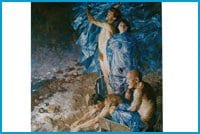Daniel Barkley paints excellent corpses — that is a high compliment, indeed. Barkley’s work, showing concurrently at the O’Connor Gallery and the east room of University Of Toronto’s JM Barnicke Gallery, consists of nude bodies, mostly male, mostly young and nubile, mostly painted in dull greys, bruise purples and morgue-cold blues. More often than not, the brightest part of a given painting is a redhead model’s sprightly bush of pubic hair. Still, this leaden palette choice is his major saving grace.
Barkley’s canvases are strange concoctions: young men and boys (and the odd oldie thrown in for good measure) marching to and fro in dream-like nowhere spaces — the recurring vista in both shows is a long, grey beach — involved in tasks so nonsensical, they can’t be anything other than allegory. Barkley seems fond of repeating models and motifs, so by the time you’re done touring the shows, seeing a barely pubescent boy perched astride a wooden horse on wheels on a drab shore becomes as familiar as your right hand. Barkley is also fond of dousing his models in strange liquids, so seeing nude men covered in runny ink or caked cement soon seems bizarrely commonplace as well.
But the element that communicates most forcefully is not Barkley’s strange tableaux, nor his exquisitely flawless drawing, but his colours. Without his cadaverous colour scheme, as RM Vaughan points out in his essay for the O’Connor show, this would just be yet more beefcake. More than anything else, his palette dictates the mood of his work; the contrast between the beauty of the figures and their sallow flesh unsettles you, and encourages you to attempt untying all the strands of his metaphors.
Of course, colour isn’t everything. After all, without the formal chops to back it up, Barkley could be as cold as he wants with his pigments and it wouldn’t mean much. His drawing is precise and detailed without being laboured or clinical; his figures are beautifully rendered, earthy and solid.
Sometimes, however, his instincts get the better of him. There is an unnerving attention to detail in these paintings — the wood grain of a rickety raft is just so, this strand of pubic hair is mathematically precise — and this is not always for the best. Barkley seems un-willing (or unable?) to know where to concentrate his formidable visual attention, and when to abandon it. In his larger works, this hampers him terribly, as a wall-sized painting crammed edge-to-edge with nitpicky detail makes for dizzying viewing. Likewise, another recurring element is wrapping his models in blue plastic tarpaulins whose every fold and highlight is recorded with scientific precision. This might be an impressive feat of rendering, but on canvas, it just looks like an overdetermined mess. The works at O’Connor are better in this regard, because they’re smaller, and this seems to rein him in; his brushwork is sparer, more efficient and much more evocative.
Still, harping on an excess of nitpicky details is, well, nitpicky. There are some excellent works in both shows. The watercolours are light and fluid and the Lazarus paintings — fragile, haunted-looking men who stare back at you from behind a heavy caking of earth and runny grey mud — are chilling. The best of his large works are stately, reminiscent in their puzzling grandeur of 19th-century Symbolism. His smaller work is lush and involving. His paintings, in all their loopy psychosexual narratives, are literary (all those boys perched on wooden-horseback screamed DH Lawrence to me), self-aware and, as I’m so fond of pointing out, not willing to rest on the gorgeousness of his models. All told, Barkley paints himself a mean corpse.

 Why you can trust Xtra
Why you can trust Xtra


